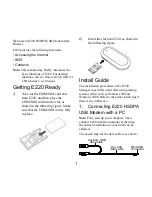
3 Installation
With proper settings the peak envelope power will nearly be equal to the maximum
output power of the TRX. In this case the average power will approximately be the half of
the maximum power, so also continuous operation will not cause problems at all. Don’t
be confused as many modern TRX only display the peak envelope power. If it is
necessary to set the MIC-Gain value to more than half of ist maximum, it is
recommended to increase the
PSKAmpl
value. This for example can be done entering
<ESC>
FSKA
200
<RETURN> If no MIC-Gain potentiometer is available the proper
PSK amplitude setting has to be evaluated with only using the
PSKAmpl
command.
After the PSK amplitude is carefully adjusted, the MIC-Gain setting at the transceiver
should not be touched any more, otherwise it could be difficult to achieve the desired
output level for non-PSK modes.
To adjust the output level for non-PSK modes (FSK, CW, PACTOR-I, AMTOR, RTTY)
only the
FSKAmpl
command should be used now. Entering
U
1
<RETURN> starts the
Unproto mode 1 (=100Bd FSK). Now you have the chance to adjust the output value
using the
FSKAmpl
command e.g. <ESC>
FSKA
100 <RETURN>
. Same as before,
during this procedure take care for not to exceed the ALC limit.
To prevent damage from the transceiver at continuous operation we recommend to limit
the FSK output level to half of the maximum possible, that means 50 W if the transceiver
is made for 100 W at max.
3.3.4.1
PACTOR-III
For optimum PACTOR-III data throughput, the transmit signal must be clean and
undistorted. Make sure that ground loops and RF feedback effects are avoided in your
installation. A 1:4 voltage divider placed directly at the transmit audio input of the
transmitter may help to improve the effective transmit SNR. Then you have to set FSKA
and PSKA to appropriate higher signal levels. PSKA levels lower than 80 are generally
not recommended. If possible, minimize the wiring between the PTC and other devices: If
the transceiver provides a power supply output (e.g. 13.8 V), do not use an extra power
supply for the PTC but connect the PTC to the DC output of the transceiver. Use
additional RF chokes wherever applicable.
Do not overdrive the transmitter (under no circumstances): The ALC level must not
exceed the proper range!
Some “noise blankers” as well as other “noise reduction tools” tend to distort the
PACTOR-III receive signal. In case of receiving problems try out if switching off the
“noise blanker” etc. improves the throughput.
Make sure that the PACTOR-III receive signal is centered properly within the IF filter
passband (see “tone monitor”). Adjusting the “passband tuning / IF shift” improves the
throughput in some cases.
15
Summary of Contents for PTC-IIex
Page 14: ...List of Figures and Tables XII...
Page 30: ...3 Installation 16...
Page 108: ...7 Audio 94...
Page 126: ...8 FAX 112...
Page 173: ...12 SYStest 159...
Page 183: ...14 Circuit Description 169...
Page 195: ...15 Basics 181...
Page 201: ...B Technical Data 187...
Page 202: ...C Layout Appendix C 19 Layout B 1 Motherboard Figure B 1 Motherboard 188...
Page 203: ...C Layout 189...
Page 215: ...Index 202...
















































